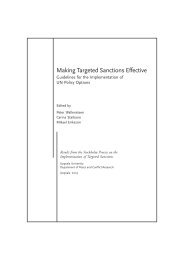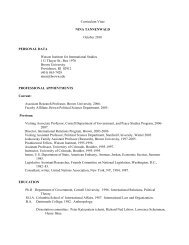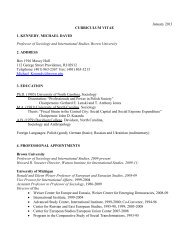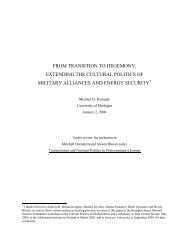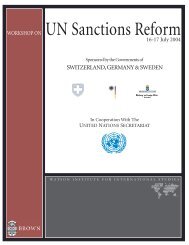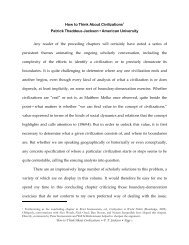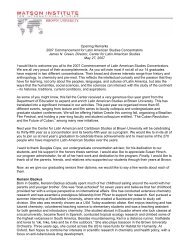op 18 front pages-converted - The Watson Institute for International ...
op 18 front pages-converted - The Watson Institute for International ...
op 18 front pages-converted - The Watson Institute for International ...
You also want an ePaper? Increase the reach of your titles
YUMPU automatically turns print PDFs into web optimized ePapers that Google loves.
How many persons were reached by U.N. humanitarian<br />
assistance in any <strong>for</strong>m at any time? Each new United Nations<br />
appeal noted an increase in the number of intended beneficiaries<br />
but did not indicate how many persons had been reached<br />
during the previous period. In the food sector, <strong>for</strong> example—<br />
which the U.N. considered its signature contribution and<br />
where the best data is available—the estimated percentages of<br />
those reached varied from area to area.<br />
In Slovenia, where conflict did not impede distribution,<br />
the World Food Programme (WFP) calculated that it had<br />
supplied food to the total target p<strong>op</strong>ulation of about 60,000<br />
registered refugees. In war-ridden Bosnia and Herzegovina,<br />
where in September 1993 there were 2.28 million pe<strong>op</strong>le in<br />
need of food, WFP estimated that it met about 70 percent of<br />
food needs. That figure was expected to decrease during the<br />
latter months of the year, reflecting a target p<strong>op</strong>ulation increase<br />
to 2.74 million pe<strong>op</strong>le, winter rations expanded from<br />
535 to 610 grams per day, and more obstacles to deliveries.<br />
In enclaves within Bosnia and Herzegovina, the percentages<br />
of needs met were lower still. During the first nine<br />
months of the year, as illustrated in Figure 2.2, U.N. food aid<br />
met 52.4 percent of the needs of the civilian p<strong>op</strong>ulation in<br />
Zepa, 42.9 percent in Srebrenica, and 26.4 percent in Goradze.<br />
<strong>The</strong> percentages would have increased if food air-dr<strong>op</strong>ped by<br />
NATO <strong>op</strong>erations—roughly 1,000, 2,000, and 3,000 tons to the<br />
three enclaves during the same period—had been included.<br />
Because of deteriorating security conditions, however, overland<br />
food deliveries were expected to meet an even smaller<br />
pr<strong>op</strong>ortion of food needs in the final months of the year. <strong>The</strong><br />
percentages reached were inversely related to the numbers of<br />
those in need, estimated in late 1993 at 10,000 in Zepa, 44,140<br />
in Srebrenica, and 66,000 in Goradze.<br />
<strong>The</strong> unusually low percentages of distribution in the enclaves<br />
reflected how much the delivery of food was complicated<br />
by the war. Fighting in eastern Bosnia between the<br />
Bosnian army and Serbian <strong>for</strong>ces throughout 1993 impeded<br />
deliveries from the Dalmatian coast, Serbia, and outside the<br />
region. <strong>The</strong> outbreak of fighting between the Bosnian army<br />
and Croatian <strong>for</strong>ces in central Bosnia in the spring of 1993 cut<br />
the convoy routes from the coast, impeding food deliveries to<br />
14



